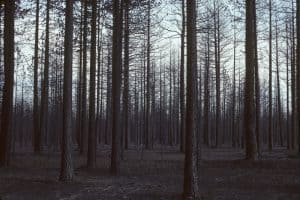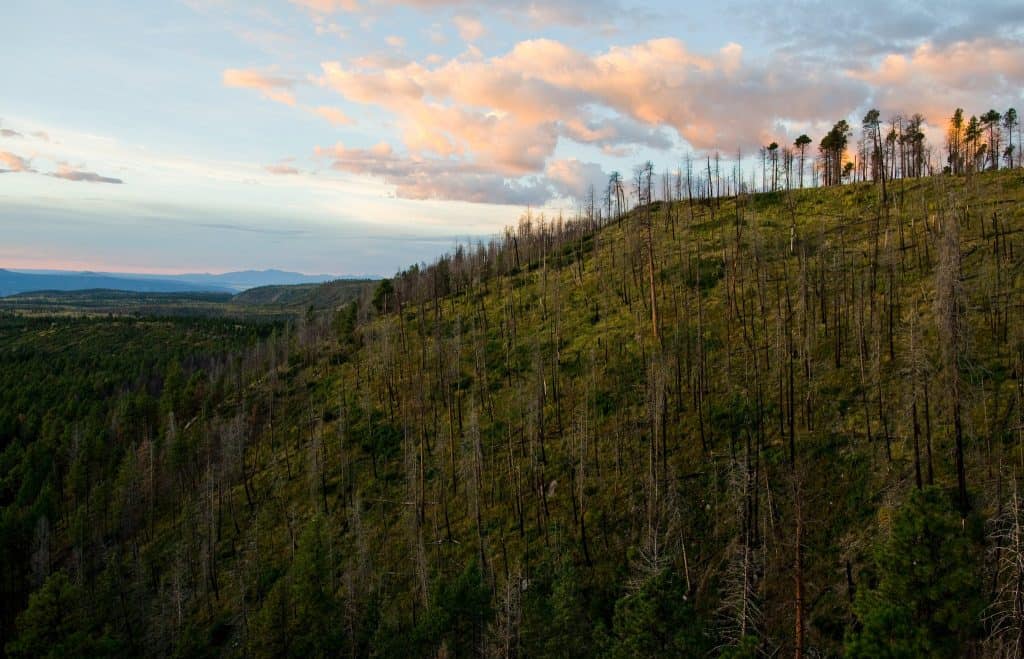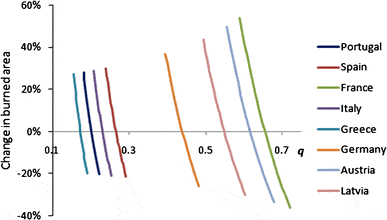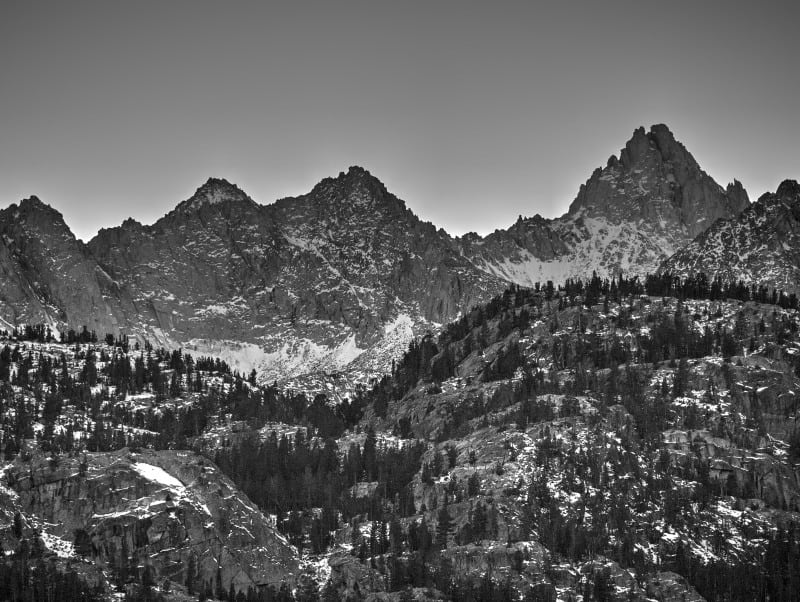This is for those who insist that we don’t need to use forest management to reduce the risk of catastrophic loss to wildfire. Several people have expressed unscientific views on this site to the effect that ‘Wildfire is climate driven and no amount of controlled burns and or thinning can have any impact on total acreage burned since it is all due to global warming (drought and high winds)’ Hopefully this will bring them to their senses and open their minds to the possibility that they are flat out wrong.
Several of us have tried to explain that global warming only makes the need for managing stand density even more important. We have also tried to explain that what many see as climate driven firestorms are instead micro climate created by the fire. Hence the need to use the appropriate forest management tools to reduce the risk of an ignition spreading at a rate that will create its own weather and to provide opportunities for crown fires to return to the ground in order to allow the fire to be controlled as is appropriate for the specific situation.
I have rightly or wrongly gotten the impression that some here don’t really respect the research done on wildfire for at least the last 80 years. My reason for saying this is the applause they afford to people who come up with conclusions contrary to the science but don’t bother to reconcile their suppositions/theories, based on cherry picked incidents, with the established and well replicated science.
So here is an article that should give you a better understanding of and respect for the work behind the real science and how it corroborates what some of us have repeatedly stated here and elsewhere so, obviously, the principles described here are not new – They are just getting a whole lot more attention as technology has advanced to the point where tools are now available to make precise measurements on what has only been repeatedly observed before. This is a pretty intense read and well worth reading in its entirety.
1) ‘“It looked,” says Kingsmill, “like a nuclear bomb.”
Undaunted, Kingsmill and the pilot decided to do what no research aircraft had done: Fly directly through the plume.’
2) ‘For decades, scientists have focused on the ways that topography and fuels, such as the trees, grass or houses consumed by flames, shape fire behavior, in part because these things can be studied even when a fire isn’t burning. But this line of inquiry has offered only partial answers to why certain blazes, like the Pioneer Fire, lash out in dangerous and unexpected ways — a problem magnified by severe drought, heat and decades of fire suppression.’
3) ‘“The plume is orders of magnitude harder to study than the stuff on the ground,” says Brian Potter, a meteorologist with the Pacific Wildland Fire Sciences Laboratory in Seattle who sometimes works with Clements. Indeed, it took a global conflagration much darker than any forest fire to even begin laying the foundations of this work. Kingsmill’s observation about the bomb, it turns out, isn’t far off.’
–> Here the article dives off into the beginning of fire study as it began in the early ’40’s in preparation for the British bombing of Hamburg, Germany on July 27, 1943 when ‘42,000 people died, and another 37,000 were injured’
4) ‘these old experiments, finished by 1970, are still a key source of knowledge about extreme fire behaviors. Until recently, technology was simply too limited to reveal much more about the specific mechanisms by which a fire plume might feed a firestorm, let alone how beasts like fire tornadoes and fireballs form.’
5) ‘His instrument towers, deployed in carefully controlled fires, provided yet more unprecedented and precise measurements: how winds accelerate and draft into an advancing flame front, the heat and turbulence above the flames, and the speed of the rising hot air.’
6) ‘Clements wanted to capture the whole phenomenon — to look inside the opaque mass of an entire fire plume from a distance, and see all of its parts swirling at once. In 2011, he found his lens: a technology called Doppler lidar.’
7) ‘The team’s insight about the Bald and Eiler fires has implications for predicting smoke and air quality — a constant concern for communities near large fires. It also impacted the fires themselves. Even though both fires existed in the same atmospheric environment of pressures and winds, and burned across similar terrain, they were spreading in opposite directions that day — Bald to the south, and Eiler to the north. This denser current of cold air and smoke was actually pulling the Bald Fire in the opposite direction of what was predicted based on wind alone.’
8) ‘Coen works at the National Center for Atmospheric Research in Boulder, Colorado, where she studies fire’s inner workings. In September 1998, she spent several hours aboard a Hercules C-130 aircraft as it circled over Glacier National Park. The McDonald Creek Fire was marching up a steep slope at roughly three feet per second. Its smoke obscured the advancing flames, but infrared video cameras mounted outside the plane recorded what was happening underneath. It was only later, as Coen looked through individual frames of that video, that she noticed something strange: At one point, a jet of flame seemed to shoot ahead of the fire. It lasted only a second or two, but left a trail of newly ignited vegetation in front of the fire. Not until Coen calculated the size of the pixels and the time between frames could she appreciate its true significance.
The jet had surged 100 yards ahead of the fire’s front, advancing 100 mph — “like a flamethrower,” she says. It was 10 times faster than the local wind — generated, somehow, by the fire’s own internal tumult.
Coen called it the “finger of death,” and for her it brought to mind the unconfirmed reports of fireballs that occasionally circulated among firefighters.
She had never seen such a thing, but as she examined footage of other fires, she was surprised to find fire jets again and again.’
9) ‘Finney’s slow-motion videos show that these rolling eddies exist in pairs within the fire. They roll in opposite directions, coupled like interlocking gears. Their combined motion periodically pushes down on the advancing front of the fire, causing flames to lick downward and forward, ahead of the fire.
Finney believes that these forward flame-licks are scaled-down versions of the “fingers of death” that Coen has seen in wildfires — possibly even related to the fireballs said to have shot out of buildings during the 1943 Hamburg firestorm.
Coen has actually documented similar flame-rollers in real wildfires using infrared video. But she believes that the finger of death also requires another factor. As bushes and trees are heated by an approaching fire, their decomposing cellulose releases hydrogen, methane, carbon monoxide and other flammable gases in a process called pyrolysis.
Coen and Shankar Mahalingam, a fluid-dynamics engineer at the University of Alabama in Huntsville, believe that rolling currents can mix these flammable gases with oxygen-rich air. “The dangerous situation is when the fire is going up on a hill,” says Mahalingam. “Maybe there are pyrolysis products that have accumulated” in front of the fire and mixed with fire-boosting oxygen. As the flame licks forward into this invisible tinderbox, it ignites a blowtorch. … These same buoyant gases also supply the momentum that drives a fire whirl to spin once it is triggered. And on a much larger scale, they are what pushes a fire plume ever higher in the sky, powering the in-drafts that keep the fire burning below.’
10) ‘what drew Potter’s interest was the water. Concentrations of water vapor rose 10 to 20 times higher than the surrounding air.
Water is a major product of combustion, second only to carbon dioxide. It forms as oxygen binds to the hydrogen atoms in wood, gasoline or just about any other fuel — creating hydrogen oxide, otherwise known as H2O. Burning four pounds of perfectly dry wood releases a pound or two of water. …
And yet water vapor fuels the strongest updrafts in nature, says Potter, from thunderstorms to tornadoes to hurricanes. As moist air rises during these storms, the water vapor condenses into cloud droplets, releasing a small amount of heat that keeps the air slightly warmer than its surroundings, so it continues to rise. “Water,” he says, “is the difference between a weak updraft and a really powerful updraft.”’
11) ‘He believes that water was pivotal in fueling the firestorm that swept through the suburbs of Canberra, the Australian capital, on Jan. 18, 2003.
The fire consumed 200,000 acres of drought-stricken territory that day, isolating the city under a glowing haze of Halloween orange. Remote infrared scans suggest that during a single 10-minute period, it released heat equivalent to 22,000 tons of TNT — 50 percent more than the energy unleashed by the atomic bomb dropped on Hiroshima.’
12) ‘When N2UW flew through the plume of the Pioneer Fire in 2016, its instruments registered updrafts of 80 to 100 miles per hour. Yet at that elevation, 8,000 feet above the flames, the interior of the plume was only 3 to 6 degrees Fahrenheit warmer than the surrounding air, meaning that its buoyant stampede through the atmosphere was powered by a density difference of just about 1 percent.
In other words, given the right atmospheric conditions, a few degrees of warmth and extra buoyancy could spell the difference between a plume that pushes 40,000 feet up, into the stratosphere, powering a vicious blaze on the ground — as Pioneer did — and one whose smoke never escapes the top of the boundary layer at 3,000 feet, leaving the fire stunted, like a weather-beaten dwarf tree gasping for life at timberline.’
13) ‘Clements’s trained eye began to pick out some basic structures: a 40 mph downdraft next to a 60 mph updraft signified a turbulent eddy on the edge of the plume. Hot air pushing up past cooler, stationary air had set in motion a tumbling, horizontal vortex — the sort of thing that could easily have accounted for the plane’s brief freefall. Those blotchy radar pictures may finally allow us to see through wildfire’s impulsive, chaotic veneer’
Yes, professional wildfire researchers, the in air observations of pilots of spotters and retardant dropping planes and the on the ground observations of fire crews that point the researchers in various directions all deserve our respect. They actually put their lives on the line as opposed to those who disdain their commitment and repeatedly validated science.
Contact the author if you want references or check back in some previous postings on this site for some related references. I post this without references because it jives with the known and validated science that I have critically studied since I first started my forestry education in 1963.





